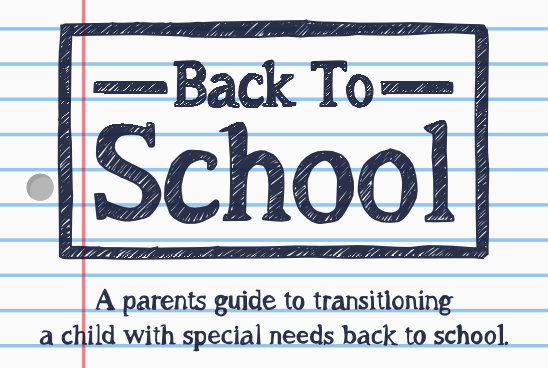
Special Education  Looking for more Back To School Tips? Checkout the Back To School Ebook with over 40 pages of helpful information on transitioning your child with special needs back to school.
Looking for more Back To School Tips? Checkout the Back To School Ebook with over 40 pages of helpful information on transitioning your child with special needs back to school.
10 Back to School Tips for Kids with Autism and Special Needs
It may feel like mid summer but schools are revving up for a new school year. Whereas summer may mean a more relaxed schedule, time to explore different interests and meet new friends; school brings more structure, routine and a steady pace. If you haven’t already, you will soon be receiving school supply lists and other important information from your child’s school. Now is the time to prepare. An “ounce” of preparation can go far! Lets take a look at supplies, routine and dress before you start out to school this year so you can send your kids back to school with SENSORY SMARTS and SENSORY POWER!1. Do your research
First, find out as much as you can about your child’s next year. Will they need extra support? Is the school aware of their challenges? Can you meet with your child’s teacher(s) before school starts so you can set a game plan that is comfortable for everyone?2. Dress for Success
Does your school have a dress code? Makes sure you include the “Dress for Success” code too: a calming deep pressure shirt which can be worn alone, under a vest, or under a school uniform; weighted or pressure vest to be worn in intervals or during mores stressful times; seamless under garments with no tags; backpack that is easy to manage; fidgets to keep in handy when needed; and perhaps a weighted cap.3. Is the School Sensory Friendly?
If you child needs sensory breaks, is the school set up? Perhaps a meeting and a bit of “sensory room” education may not only help your child but many others. Does your child’s classroom have a Break Box? This may be a good time to suggest one for your child’s classroom. The teacher may really appreciate the gift!4. Put Some Energy in your Routines
Take a look at your morning and afternoon routines. A bit of coordination and movement either before getting in the car or bus may prove highly beneficial. Do you have some things at home that you can set up? A trampoline? An obstacle course? A swing?5. Start Minimizing Electronics
They can be great for use at certain intervals but if your child is on them too much, it can cause a difficult transition back to school. Try setting scheduled times.6. Meal Planning for Success
Plan some menus that will boost up your child’s brain and immune system. If you send in snacks or lunch try considerations some great sensory foods that are crunchy and chewy such as celery, apples and carrot sticks. Stay away from packing sweets, which can spike sugar levels and cause a mid day crash.7. Check out some Sensory Friendly School Supplies
In addition to pencils and glue for school supplies, your child may benefit from adaptive paper, pencil grips or a wobbly cushion. These items may or may not be on your school supply list, so be sure to check with the school if you feel your child would benefit from using them.8. Add Some Work to the Schedule Now
Begin a little bit of scheduled “work time” during the afternoon for reading, math or other subjects.9. Post the Schedule for the Day in the House
Create a morning and afternoon schedule and post it up on the wall so everyone is aware.10. Stay Positive
Keep and upbeat attitude about school starting and make sure you check in with your child’s teacher(s) a week or two after school starts if a meeting is not already in place. Have a wonderful school year!! Looking for more Back To School Tips? Checkout the Back To School Ebook with over 40 pages of helpful information on transitioning your child with special needs back to school.
Looking for more Back To School Tips? Checkout the Back To School Ebook with over 40 pages of helpful information on transitioning your child with special needs back to school. 


